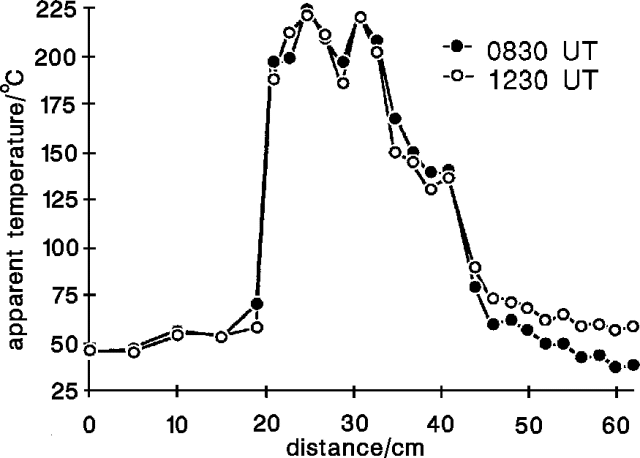Report on Vulcano (Italy) — November 1988
Scientific Event Alert Network Bulletin, vol. 13, no. 11 (November 1988)
Managing Editor: Lindsay McClelland.
Vulcano (Italy) Fumarole temperature profiles
Please cite this report as:
Global Volcanism Program, 1988. Report on Vulcano (Italy) (McClelland, L., ed.). Scientific Event Alert Network Bulletin, 13:11. Smithsonian Institution. https://doi.org/10.5479/si.GVP.SEAN198811-211050
Vulcano
Italy
38.404°N, 14.962°E; summit elev. 500 m
All times are local (unless otherwise noted)
Geologists visited Vulcano on 25 and 30 October and 1, 7, and 8 November to obtain spatial and temporal surface temperature distributions (figure 5). Fumaroles typically formed linear zones of acid steam discharge. Transects of a zone extending 40 m somewhat radially along the N rim of Gran Cratere were surveyed.
Gas temperatures (recorded by a thermocouple) were stable during the visits. The highest temperature measured was 396°C, although surface temperatures above 300°C were uncommon and highly localized (<0.01 m2) near vents. Because sublimates were unstable above about 150°C, there was a gray sublimate-free belt within 5-40 cm of the vents, flanked on either side first by white ammonium chloride, then yellow sulfur sublimates.
Further Reference. Oppenheimer, C., and Rothery, D., 1991, Infrared monitoring of volcanoes by satellite: J. of the Geological Society, London, v. 148, p. 563-569.
Geological Summary. The word volcano is derived from Vulcano stratovolcano in Italy's Aeolian Islands. Vulcano was constructed during six stages over the past 136,000 years. Two overlapping calderas, the 2.5-km-wide Caldera del Piano on the SE and the 4-km-wide Caldera della Fossa on the NW, were formed at about 100,000 and 24,000-15,000 years ago, respectively, and volcanism has migrated north over time. La Fossa cone, active throughout the Holocene and the location of most historical eruptions, occupies the 3-km-wide Caldera della Fossa at the NW end of the elongated 3 x 7 km island. The Vulcanello lava platform is a low, roughly circular peninsula on the northern tip of Vulcano that was formed as an island beginning more than 2,000 years ago and was connected to the main island in about 1550 CE. Vulcanello is capped by three pyroclastic cones and was active intermittently until the 16th century. Explosive activity took place at the Fossa cone from 1898 to 1900.
Information Contacts: C. Oppenheimer and D. Rothery, Open Univ.


